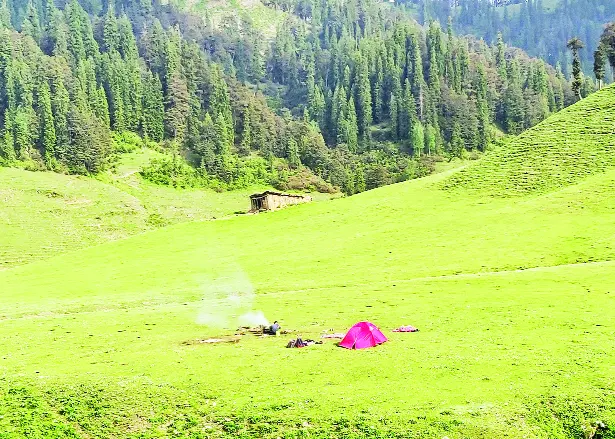By: Sadaket Malik
Tucked away from the hustle bustle of Doda are the chilly terrains, where spirituality attunes the skies amid lush green meadows and historical antiquities like Nargowari. It is located in Bhalessa’s chilly area and is a common pasture for the dwellers and ethnic population of Pingal and chilly of Bhalessa. The place stands as a picturesque destination, waiting to be explored.
Accessible through the scenic route from Malik Pura, the journey unfolds with breath-taking views and hidden treasures, including the renowned Zumun Nallah and the rustic charm of Chawuwali, a famous dhok associated with the affluent Lala Malik.
Lala Malik, the once-proclaimed richest individual in this area, left behind a legacy intertwined with the essence of the meadows. His dhok in Chawuwali near chilly adds a touch of history to the journey, echoing tales of prosperity and community life.
As we traverse the challenging yet exhilarating terrains, the allure of this place becomes more apparent. Steep slopes paint a rugged canvas, appealing to adventure enthusiasts seeking an adrenaline rush. The untamed beauty of the landscape beckons for economic development, presenting opportunities for sustainable growth and community upliftment.
To fully unlock its potential, the need for a well-connected road is evident. A road network would not only ease accessibility for locals but also open doors for tourism, inviting travelers to experience the unspoiled charm of this tourism hotspot. The establishment of tourist huts could further enhance the visitor experience, providing a comfortable retreat amid nature’s bounty.
The natural wonders surrounding it make it a haven for nature lovers, photographers, and adventure seekers. From Malik Pura to Zumun Nallah and the rich history encapsulated in Chawuwali, every step of the journey offers a glimpse into the soul of the area.
Nargowari in Takri records:
This place is mentioned in the takri records. The place has been leased out by labh joo Kardar of Bhalessa.
Leasing out of two Dhars Nargowari and Gasheer Top by Labh Joo Kardar of Bhalessa is evident in the state archives department. Probably in Maharaja Ranbir Singh’s time these leases took place.
The Pasture land was bestowed by Piar Singh Kardar of Bahadarwah Pargana to Laj Singh Kardar of Bhales Pargana, who in turn bestowed it to Dido Jugani.
The Patta is dated 6th Sawan Samvat 1915 (probably) which corresponds to July 18th 1858 A.D.
Translation of Wazir Labh joo’s Patta, dated 6th Sawan, samvat 1915 reads as under :
“The Dhars of Nargowari and Gasheer have been leased out to two men, Rani Gagan and Basya Thakkar, of Pingal. The sum of Rs. 84 on account of their lease money to be recovered by the Sirkar with grazing dues in addition to the lease money. The amount of leases was Rs 70 before, which has now been increased and the Dhars have been leased out to him Observance should be made accordingly”.
The archives also reveal the Patta of NarGowari and Gasheer Top in detail and has a dossier of it as enunciated inTakri records. Since Nooran Gowari stands as heritage site.
The place is a masterpiece of nature, with snow-capped peaks, pristine valleys, and crystal-clear rivers. The region’s undisturbed beauty not only provides a serene escape but also sets the stage for a thrilling adventure.
For avid trackers, Nar Gowari offers a network of trails that wind through lush meadows and dense forests, providing an immersive experience with nature. Whether you’re a seasoned hiker or a novice adventurer, the varied landscapes cater to different skill levels, promising a journey of great thrill.
Mountaineers, drawn to the allure of challenging peaks, will find NarGowari to be a playground of possibilities. Majestic summits surround the region, inviting those with a passion for conquering heights. The panoramic views from the mountain summits are rewards in themselves, showcasing the unparalleled beauty of Jammu and Kashmir.
Beyond its natural wonders, NarGowari is steeped in local culture and traditions. Visitors can immerse themselves in the warm hospitality of the locals, savoring traditional cuisine and participating in cultural events that add a unique flavor to the overall experience.
While promoting tourism, it is crucial to emphasize sustainable practices. Its allure lies in its untouched landscapes, and responsible tourism ensures the preservation of its ecological balance. Local initiatives can be implemented to protect the flora and fauna, ensuring that future generations can also revel in the region’s natural splendor.
To unlock its potential, investing in infrastructure and accessibility is paramount. Well-maintained trails, comfortable accommodations, and reliable transportation will enhance the overall visitor experience, making it more accessible to a broader audience.
The place stands as a beacon of untapped potential for Jammu and Kashmir’s tourism industry. As it beckons trackers and mountaineers to explore its natural wonders, a harmonious blend of adventure and cultural richness awaits those who venture into its chilly embrace. With responsible tourism practices and thoughtful development, it has the promise to become a cherished destination, leaving an indelible mark on the hearts of those who seek both serenity and excitement amidst the snow-clad peaks.
Nargowari acts as a symbiotic relationship between nature and history, waiting to be discovered. As we envision a future of connectivity and sustainable development, unlocking the potential of this hidden paradise could pave the way for a harmonious blend of adventure, heritage, and economic prosperity. The nargowari need to be brought under the preview of the heritage list by the UNESCO.
Sadaket Malik is an author of the book “Cultural History of valley of chenab”






 By : Shabir Ibn Noor
By : Shabir Ibn Noor
